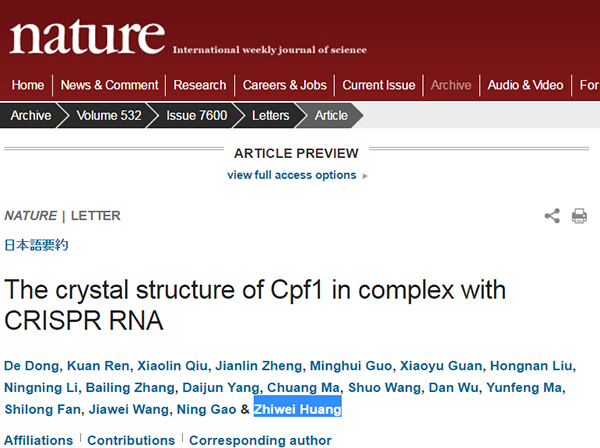Professor Huang Zhiwei of Harbin Institute of Technology: Nature's paper reveals rewriting life gene scissors
On April 27, 2017, Prof. Huang Zhiwei from the School of Life Science and Technology of Harbin Institute of Technology published a new achievement in the journal Nature entitled “Structural basis of CRISPR–SpyCas9 inhibition by an anti-CRISPR proteinâ€. The paper reveals the "magic scissors" that rewrites life - the molecular mechanism by which the CRISPR system "closes the switch" anti-CRISPR inhibits the activity of SpyCas9.
The CRISPR/Cas system was originally an adaptive immune system used by bacteria to protect itself from bacteriophage infections. In recent years, CRISPR/Cas9 (SpyCas9) has been widely used in biomedical research worldwide. Some clinical trials based on this gene editing technique are also underway. Considering the safety of clinical applications, scientists from all over the world are actively addressing the problem of gene editing off-target effects caused by over-activation or long-term effects.

Professor Huang Zhiwei
In December 2016, Cell Magazine published an important achievement (paper: Inhibition of CRISPR-Cas9 with Bacteriophage Proteins). This study identified "closed development" anti-CRISPRs: AcrIIA2 and AcrIIA4, which both block the editing activity of the CRISPR system in both bacterial and human cells. They are capable of blocking the activity of the Cas9/SpyCas9 enzyme in the CRISPR system. Scientists believe that the discovery of anti-CRISPR will provide an important means to improve the security of the CRISPR system.
So, what is the molecular mechanism by which these anti-CRISPRs inhibit SpyCas9 activity? This Nature paper by Professor Huang Zhiwei's research group answered this question. The team said the results provide the structural basis for designing genetically editable tools that specifically or conditionally control SpyCas9 activity in time or space.
In an interview with Bio Discovery, Professor Huang Zhiwei said: "At present, research groups around the world are conducting CRISPR technology for the treatment of various diseases. If you want this technology to be applied clinically, you must ensure its safety. This is like, for the car, the power system and the brake system are indispensable. We must find the 'brake system' of the CRISPR system to make its activity controllable."
Entering the field of CRISPR is a matter of course, and multiple results "decipher" different systems
In fact, Professor Huang Zhiwei's research group, which has conducted CRISPR-related research for only two or three years, has published several research results in journals such as Nature and Cell Research. "CRISPR is the adaptive immune system of bacteria. Our laboratory was originally conducting research related to the interaction between pathogens and hosts. It is logical to enter the field of CRISPR," he said.

Single use only.
Imported IC can have an accurate result.
Model: Adult, Enfant, Infant, Newborn.
Certification: CE, ISO
SPO2 Sensor,Disposable Fingertip SPO2 Sensor,Fingertip SPO2 Sensor,Adult Fingertip Pulse Sensor
Zhejiang Haisheng Medical Device Co., Ltd , https://www.hisernmedical.com